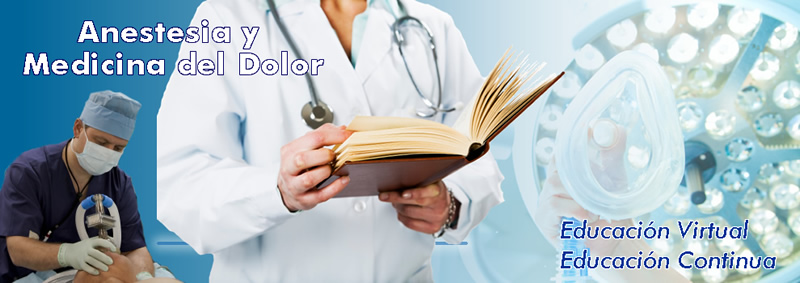|
Sedación volátil en terapia intensiva. Revisión sistemática y meta-análisis
Volatile sedation in the intensive care unit: A systematic review and meta-analysis.
Abstract
BACKGROUND: Volatile sedation in the intensive care unit (ICU) may reduce the number of adverse events and improve patient outcomes compared with intravenous (IV) sedation. We performed a systematic review and meta-analysis comparing the effects of volatile and IV sedation in adult ICU patients. ..... CONCLUSION: Compared with IV sedation, volatile sedation administered through an ACD in the ICU shortened the awakening and extubation times. Considering the difference in serum troponin levels between both arms, volatile anesthetics might have a myocardial protective effect after cardiac surgery even at a subanesthetic dose. Because the included studies used small sample sizes with high heterogeneity, further large, high-quality prospective clinical trials are needed to confirm our findings.
|
Seguridad y eficacia de los agentes anestésicos volátiles en comparación con la sedación estándar intravenosa con midazolam / propofol en pacientes con ventilación mecánica en cuidados intensivos ventilados: un metanálisis y revisión sistemática de ensayos prospectivos.
Safety and Efficacy of Volatile Anesthetic Agents Compared With Standard Intravenous Midazolam/Propofol Sedation in Ventilated Critical Care Patients: A Meta-analysis and Systematic Review of Prospective Trials.
Anesth Analg. 2017 Apr;124(4):1190-1199. doi: 10.1213/ANE.0000000000001634.
Abstract
BACKGROUND: Inhalation agents are being used in place of intravenous agents to provide sedation in some intensive care units. We performed a systematic review and meta-analysis of prospective randomized controlled trials, which compared the use of volatile agents versus intravenous midazolam or propofol in critical care units. METHODS: A search was conducted using MEDLINE (1946-2015), EMBASE (1947-2015), Web of Science index (1900-2015), and Cochrane Central Register of Controlled Trials. Eligible studies included randomized controlled trials comparing inhaled volatile (desflurane, sevoflurane, and isoflurane) sedation to intravenous midazolam or propofol. Primary outcome assessed the effect of volatile-based sedation on extubation times (time between discontinuing sedation and tracheal extubation). Secondary outcomes included time to obey verbal commands, proportion of time spent in target sedation, nausea and vomiting, mortality, length of intensive care unit, and length of hospital stay. Heterogeneity was assessed using the I statistic. Outcomes were assessed using a random or fixed-effects model depending on heterogeneity. RESULTS: Eight trials with 523 patients comparing all volatile agents with intravenous midazolam or propofol showed a reduction in extubation times using volatile agents (difference in means, -52.7 minutes; 95% confidence interval [CI], -75.1 to -30.3; P < .00001). Reductions in extubation time were greater when comparing volatiles with midazolam (difference in means, -292.2 minutes; 95% CI, -384.4 to -200.1; P < .00001) than propofol (difference in means, -29.1 minutes; 95% CI, -46.7 to -11.4; P = .001). There was no significant difference in time to obey verbal commands, proportion of time spent in target sedation, adverse events, death, or length of hospital stay. CONCLUSIONS: Volatile-based sedation demonstrates a reduction in time to extubation, with no increase in short-term adverse outcomes. Marked study heterogeneity was present, and the results show marked positive publication bias. However, a reduction in extubation time was still evident after statistical correction of publication bias. Larger clinical trials are needed to further evaluate the role of these agents as sedatives for critically ill patients.
|
Agentes volátiles en la sedación de cuidados críticos: ¿sí, no o tal vez?
Volatile agents in critical care sedation: yes, no or maybe?
Minerva Anestesiol. 2017 Jul;83(7):679-681. doi: 10.23736/S0375-9393.17.12141-3. Epub 2017 May 19.
|
Rabdomiólisis de esfuerzo e insolación: tenga cuidado con la sedación anestésica volátil.
Exertional rhabdomyolysis and heat stroke: Beware of volatile anesthetic sedation.
Abstract
In view of the enormous popularity of mass sporting events such as half-marathons, the number of patients with exertional rhabdomyolysis or exercise-induced heat stroke admitted to intensive care units (ICUs) has increased over the last decade. Because these patients have been reported to be at risk for malignant hyperthermia during general anesthesia, the intensive care community should bear in mind that the same risk of life-threatening rhabdomyolysis is present when these patients are admitted to an ICU, and volatile anesthetic sedation is chosen as the sedative technique. As illustrated by the three case studies we elaborate upon, a thorough diagnostic work-up is needed to clarify the subsequent risk of strenuous exercise, and the anesthetic exposure to volatile agents in these patients and their families. Other contraindications for the use of volatile intensive care sedation consist of known malignant hyperthermia susceptibility, congenital myopathies, Duchenne muscular dystrophy, and intracranial hypertension.
KEYWORDS: Congenital myopathies; Exertional rhabdomyolysis; Heat stroke; Inhalational anesthetics; Intensive care sedation; Malignant hyperthermia
|
Agentes volátiles en la sedación de cuidados críticos: ¿sí, no o tal vez?
Volatile agents in critical care sedation: yes, no or maybe?
Minerva Anestesiol. 2017 Jul;83(7):679-681. doi: 10.23736/S0375-9393.17.12141-3. Epub 2017 May 19.
|
Anestésicos volátiles halogenados en la unidad de cuidados intensivos: conocimiento actual sobre una práctica próxima.
Halogenated volatile anesthetics in the intensive care unit: current knowledge on an upcoming practice.
Minerva Anestesiol. 2017 Jul;83(7):737-748. doi: 10.23736/S0375-9393.17.11735-9. Epub 2017 Mar 8.
Abstract
The aim of this narrative review was to highlight key points of volatile anesthetics administration in the intensive care unit (ICU), including AnaConDa® and Mirus® devices characteristics and the reported findings on clinical outcomes in critically ill patients. Intravenous sedation in the ICU is associated with issues, such as over- and under-sedation. Halogenated compounds, which can be safely administered by inserting a device in any ICU ventilation circuit, have interesting pharmacodynamic and pharmacokinetic profiles for patients with multi-organ failure. Moreover, analysis of the concentration of exhaled volatile compounds could help evaluation of sedation depth. A recent meta-analysis confirmed that rapid washout of the volatile anesthetics improved both extubation readiness and quality of awakening when compared to intravenous sedation. When administered for a long period, volatile anesthetics improved sedation stability with fewer dose adjustments. Pre- and post-conditioning properties of halogenated compounds are interesting and long-term exposition to this compound is investigated for a potential impact on mortality rate and ICU/hospital length of stay. For now, psychomotor side effects have been reported, mostly in infants, but there were no hepatic or renal injuries. Findings regarding hemodynamic stability are conflicting. Apart from sedation, volatile anesthetics were therapeutic in case reports of status asthmaticus and epilepticus and data are cumulating for benefits in cases of acute respiratory distress syndrome. According to current literature, they should be withheld in cerebral injury. To summarize, the use of volatile anesthetics for sedation is yet only approved by German guidelines, but could spread due to its potential benefits.
|
Congresos Médicos por Especialidades en todo Mundo
Medical Congresses by Specialties around the World
|
Safe Anaesthesia Worldwide
Delivering safe anaesthesia to the world's poorest people
|
|
|
|  |
|






